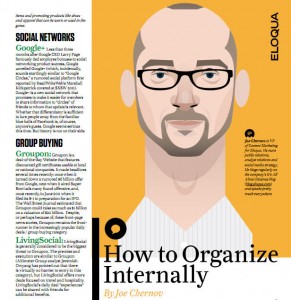Reacting to an increasingly competitive marketing automation software field, last spring Eloqua created an independent content marketing department.
The idea was to bring the company into what VP of Content Marketing at Eloqua, Joe Chernov, described as the “marketing 2.0” world — the shift from transactional marketing to social/conversational marketing.
Early in the process of putting its content marketing strategy together, Eloqua decided to differentiate itself from the competition by putting a strong emphasis on visual appeal and design elements. This means releasing a steady diet of infographics, and putting more attention on design in live events and even the typically stodgy old white paper.
Build, buy or hire?
Because visual appeal was going to be a key aspect of all its content marketing efforts, getting the right people to execute the design work was very important to Eloqua. Typically two options are considered:
- Create from scratch or utilize an existing internal art/design department within the company
- Find a vendor and pay them by the piece for each design project.
Eloqua went a third direction. It found a design firm doing the work Eloqua was looking for and put them on retainer.
And even more unconventionally, Eloqua actually gives that firm — JESS3 — prominent credit for all its work.

Example of JESS3's work (click to enlarge)
Joe says, “We give them a shout-out for everything they create and I have gotten some pushback internally saying, ‘Look, we bought this.'”
He adds, “My view is, ‘Why not?’ JESS3 is a really hot company. And if somebody is putting their name on something, aren’t they going to do the very best work versus if their name wasn’t on it?”
Joe also says Eloqua is getting additional social media and other benefits by connecting their B2B brand to a design firm with a completely different following. When a content piece, blog post or press release goes out mentioning JESS3 alongside Eloqua, the design company’s fans share those links with an entirely new demographic. And that, Joe explains, gives Eloqua additional “top of the funnel” exposure.
Sometimes reality steps in …
And every once in a while something happens that puts an easy-to-see monetary value on taking the unconventional route. Unexpected changes in content marketing publishing plans can leave a team scrambling, and paying additional fees to contract-based creative talent.
I’ll let Joe explain just that occurrence with a recent major content piece, and how having JESS3 on retainer saved Eloqua time and money:
On June 28th the Social Media ProBook was declared final. Done. Complete.
The final version had been approved and it would be published the following day. I’d even made a quip to the team, “Not one more damn edit. I don’t care if there is a typo or two. We’ll survive. This project is ‘a wrap.’ It goes live tomorrow.”
Then, later that same day, Google+ launched. How could we go live with the “social media pro’s” book on social media without so much as mentioning Google’s long-awaited re-entry into the space? We couldn’t.
So I over-ruled myself, and we scrambled to insert a section on Google+, a section that had a major impact on page layout. Had JESS3 been paid by the project, this significant last-minute change may have been an “outside of scope” addition. After all, I had just emphatically declared the project complete. But given the retainer model, our relationship isn’t a series of discrete projects, but rather a constant hum of collaboration, output and refinement.
In the case of the Social Media ProBook, we refined it after it was “final” but before it was published, thanks, in large part, to the continuity that comes with a retainer.
Related Resources
Content Marketing: Four tactics that led to $2.5 million in annual contracts (Members library)
SEO Tactics Chart: Creating content is the most-effective tactic — here’s how to get started
Inbound Marketing: Unlock the content from your emails and social marketing
Content Marketing: Should you lure a journalist over to the “dark side?”
Content Marketing: Analytics drive relevant content, 26,000 new monthly visits to blog (Members library)
Content Marketing: Inbound strategy pulls in 25% more revenue, 70% more leads (Members library)
Marketing Strategy: Revenue-oriented approach leads to 700% two-year growth (Members library)
Lead Generation: A closer look at a B2B company’s cost-per-lead and prospect generation
Lead Generation: Testing form field length reduces cost-per-lead by $10.66





 Recently, my colleague
Recently, my colleague 






